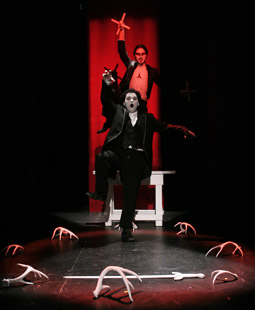the black rider: the accidents of addiction
anna russell

Michael Scholar Jnr, Kevin Corey, The Black Rider
photo Ian Jackson
Michael Scholar Jnr, Kevin Corey, The Black Rider
The stage for Black Rider is dressed only with three columns of red light on a blue background, like a triple projection of Barnet Newman’s painting Voice of Fire. But the Black Rider quotes more than modern art. It’s based on a German fable of the Middle Ages; it also reeks of the popcorn smell of the American big top and the stale grease makeup of clowns. It quotes Byron and T. S. Eliot. It has Broadway melodies and Latin rhythms. In some moments, it’s positively Gilbert and Sullivan, as envisioned by people who don’t like Gilbert and Sullivan. And in this production it’s held together by the visual continuity of actors in exaggerated makeup who can move gracefully when required, but tend more to contorted bodies and faces, and to any gesture but real.
The style of movement varies almost at random from the pointed toes and sweeping limbs of ballet to the tumbling of the circus, and exaggeratedly bent arms and twisted torsos that come from some less familiar tradition. Speech varies as dramatically. Actors sing naturally while holding crooked poses, or distort their voices past intelligibility. The text morphs from moralizing to hucksterism, exposition to character. It’s oddly alien and familiar at the same time, without necessarily creating a strong, overall effect.
In this November Theatre version of the Waits-Burroughs-Wilson original, German expressionism goes to the circus, but it’s a cheap circus playing a small town, and the performers are giving it their all. They’re talented as hell, but their aping faces and distorted limbs distract them and their cheerful audience from the fact that this is, at one level, a story about drug addiction. As some will know, Black Rider’s writer, William S. Burroughs, was a heroin addict who accidentally killed his wife in a shooting game. In this production, when Wilhelm, the inept suitor, accidentally shoots his bride on their wedding day, with a bullet he got from the Devil to give him a marksman’s skill, few will guess at the resonance. The absurd, self-mocking gestures of the actors sometimes do work to hint at the self-loathing that must accompany addiction and homicide. In one of the final scenes, the morose Wilhelm ties himself up in a straitjacket made of his own dress coat, telling us that making deals with the Devil is the province of the insane. A moment of pity allows a brief connection.
Addiction can get ugly, and this production is most successful when it’s ugly and in the rare moments of sincere emotion which punctuate a lot of intentional silliness. Kathchen (Rachael Johnston), the bride-to-be, gets to scream twice: full-bodied, deliciously ugly screams that you rarely hear on stage or anywhere else, and in this case, electronically augmented to strong effect. Sincerity appears by surprise in a production that otherwise cultivates the absurd. The doomed lovers are truly touching only once, when Wilhelm plays with Kathchen’s toes as they sing the Briar and the Rose. It’s a straightforward duet in a production that would rather discomfit and jar the audience. Wonderful inconsistencies also appear, as in a love song that mixes predictably romantic words with phrases like “I’d be the pennies on your eyes.” Death and matrimony rarely converge so playfully. Too frequently though, it’s hard to find a connection and maintain it. I spent a good chunk of the lingering death scene wondering at the strength of Johnston’s legs as she inched herself to the floor.
Is there a point in reviving German expressionism after its era has passed? Without the rancorous signing of the Treaty of Versailles after World War I, without the cabaret nightlife of Weimar Berlin, without bold experimental films like Dr. Caligari’s Cabinet, expressionism is just a romp. Artistic movements come naturally out of a particular time and place. Once, German expressionism was political. Now it’s just as moderately entertaining as anything else.






